
|   |

|   |
Natya Tarangini's Azadi ka Amrit Mahotsav - Manjari Sinha e-mail: manjari@sinha.com Photos: Rahul Naag May 20, 2023 Natya Tarangini Performing Arts Centre of Guru Raja-Radha and Kaushalya Reddy celebrated Azadi ka Amrit Mahotsav as part of World Dance Day at the Raja-Radha Ranga Manch in their premises. The three-day festival (27th - 29th April 2023) underlined the importance of our age-old tradition of Guru-Shishya Parampara by inviting dancers of different dance styles to perform with their gurus. Natya Tarangini also honoured devoted gurus like Uma Sharma - Kathak, Padma Subrahmanyam - Bharata Nrityam, Madhavi Mudgal - Odissi, Kalavati Devi - Manipuri, Kala Vijayan - Mohiniattam, and Raja-Radha Reddy - Kuchipudi on this occasion. 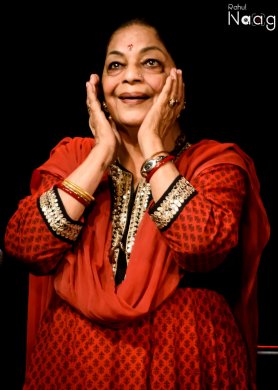 Uma Sharma 'Azadi ka Amrit Mahotsav' reached its climax with an ode to our country, conceived by Guru Raja Reddy where stalwarts from six Indian classical dance styles eulogized 'Bharat' dancing to a special Sanskrit poem 'Bhaati mey Bharatam' written by Dr Ramakant Shukla and composed by Pt. Madhup Mudgal for this special occasion. Uma Sharma created the emotional preface of 'Vasudhaiva Kutumbakam' (the whole universe is like a family) being sung in the free-flowing swaras of Bhairavi in a Bol Alap like rendering. Her involved abhinaya on the Sanskrit song in the Baithaki bhava, the most challenging and hence fast disappearing aspect of Kathak, vouched for her direct training under the legendary Guru Shambhu Maharaj. Interpreting the poem, her charged abhinaya replete with emotions of love, affection, and pride for the motherland, touched each and every member of the audience with feelings of patriotism. 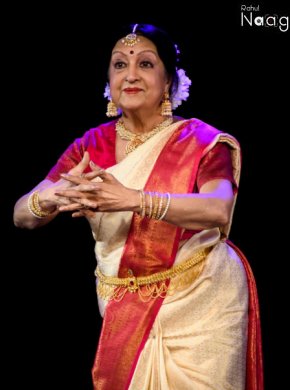 Dr. Padma Subrahmanyam Dr. Padma Subrahmanyam came next, bowing to the earth and putting the dust on her forehead with reverence, while the poem meandered the pleasing swaras of raga Bhimpalasi. She depicted the flora and fauna, birds and beasts, heralding the national flag with pride and the feeling of universal brotherhood with her graceful body movements and subtle abhinaya. 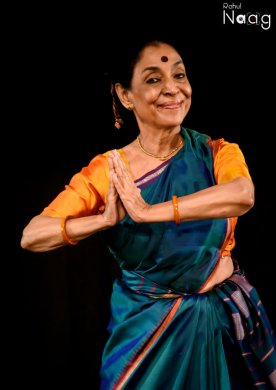 Madhavi Mudgal Pt. Madhup Mudgal had very thoughtfully used a couple of musical phrases as a chorus to differentiate dancers of different dance styles. Thus Madhavi Mudgal appeared next in Odissi with the stanza "Manavah mohitam, danavah baadhitam / vanditam, pujitam, pakshibhirkujitam / Bhutale bhaati mey Bharatam" with music taking turn towards raga Kalawati. This was followed by Mohiniattam by Guru Kala Vijayan in Malkauns, the Carnatic Hindolam. 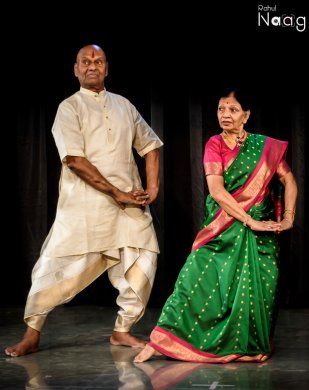 Raja and Radha Reddy Kalavati Devi brought the authentic fervour of her specific Manipuri dance style, with the high-pitched vocalist leading the orchestra. Raja-Radha Reddy danced to the Sanskrit shlokas of "Bhaati mey Bharatam" song in Kuchipudi dance style with all the dancers joining them together towards the end. No wonder this group presentation by the crowning gems of different dance forms got them a standing ovation. Mahati Kannan, the brilliant disciple and grand-niece of Dr Padma Subrahmanyam, regaled the audience earlier with her delicate grace and assertive rhythmic articulations while presenting Pushpanjali with Balamurali Krishna's Arabhi composition invoking Ganesha, Purandara Dasa's Bhajan in Natakuranji set to adi tala and the Kalinga Nartan with lyrics culled out from Narayaneeyam. Dr. Padma Subrahmanyam conceived the specific angaharas and music for this piece set to varied chhandas like Tisra, Chatusra, Khand, Misra, et al. With melodious vocal support by her mother Gayathri Kannan, resonant veena by her father Kannan Balakrishnan, and musical mridangam by Bharadwaj, Mahati charmed the audience with her bewitching Bharata Nrityam. The evening opened with the immortal welcome song "Swagatam Shubha Swagatam" written by Pt. Narendra Sharma and composed by Pt. Ravi Shankar, which was imaginatively choreographed and gracefully performed by the disciples of Gurus Raja-Radha and Kaushalya Reddy on the inaugural evening also. 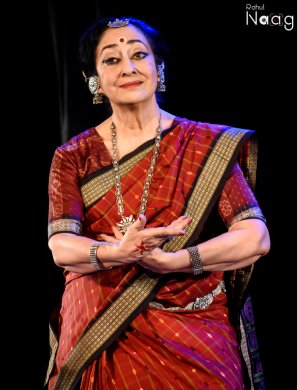 Sharon Lowen The first performance on the inaugural evening was Odissi by Guru Sharon Lowen with her disciples Madhur Gupta and Vishwanath Mangaraj, who presented Hamsadhwani Pallavi as a duet before Sharon took the stage for her solo abhinaya on Jayadeva's ashtapadi "Sakhi hey, Kesi mathanamudaram...". The emotional intensity of an 'utkanthita' Radha reminiscing her "prathama samagama" with Krishna, was brought alive by Sharon requesting her Sakhi (friend) to bring back her beloved Krishna, the killer of the demon Kesin. Sharon Lowen concluded her Odissi performance with Moksha, dancing with her disciples to the Devi Stuti "Omkaara karini..." composed by Balamurali Krishna. 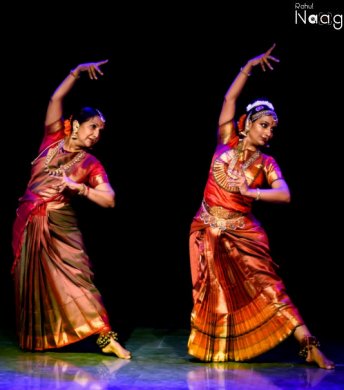 Kaushalya Reddy and Yamini Reddy Kaushalya Reddy and her gifted daughter/disciple Yamini Reddy continued with Kuchipudi where Yamini opened with the cosmic dance of Shiva, "Maha Prana Deepam." This was an energetic solo number incorporating Navarasas and Sanskrit shlokas like "Nrittavasane Nataraja Rajo nanaad dhakka nava panch varam...." comprising the Panini Sutras "Aiuna Rilrik...." that also symbolize different rhythmic chhandas like Chatusra - 'A-i-u-n', Tisra - 'Ri-lri-ka' etc. Dancing to the composition "Maha Prana Deepam, Omkara rupam, Mahasurya chandram trinetram, pavitram...," Yamini impressed the audience with her dynamic energy. The solo by Kaushalya came as a contrast with shringara rasa dripping out of the Kshetraiyya Padam "Eva adey...", where the Nayika (heroine) is parakeeya and praudha (prurient), who rejoices recalling romantic indulgence with her lover that she can't even reveal to her Sakhi. This was followed by Mandari Jathiswaram, a scintillating duet by Kaushalya Reddy and Yamini, weaving the sargam of raga Mandari as a tapestry of tune and beats. The melodious notes were given in visual form with nritta. There were no words to convey any meaning in this item but the attractive movements of the eyes, eyebrows and neck and the intricate patterns of footwork created an alluring impact. 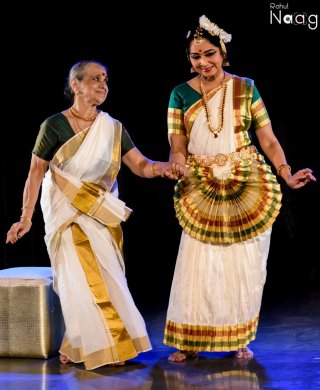 Kala Vijayan and Gopika Varma Mohiniattam by Gopika Varma heralded the second evening with her Guru Kala Vijayan who joined her later. Opening with Ganapati Vandana she presented a keerthanam on Saraswati which was about the story of Vyali on her veena. The destructive demon Vyalasura used to destroy everything. He would be calm only till he listened to her veena. So Saraswati decided to calm him permanently by placing him inside her veena. This tamed the destructive nature of Vyalasura. Gopika thanked all the veena players who keep the demon in us calm by playing veena. The second charanam of the keerthana had the story of how Adi Shankaracharya brought Devi Mookambika to Kulloor, Kerala, ending with the Sanskrit shloka "Manikya veena mupalalayanti...". Gopika's Mohiniattam presentation concluded with an interesting 'Kuratti', folklore about an argument between Lakshmi and Parwati pulling each other's leg, where her Guru Kala Vijayan joined as Parwati while she played the role of Lakshmi. Parwati comments, "I have heard that your husband is having an affair with Kubja", and pat comes Lakshmi's reply "I also know that your husband has the other woman Ganga in his locks." The argument goes on till they come to the conclusion that both are one and the same as 'Hari-Hara', and they both finally hug each other! The hilarious abhinaya by both Guru Kala Vijayan and her shishya Gopika left the audience in splits of laughter.  Kalavati Devi and Bimbavati Devi The second performance of the second evening was a Manipuri performance by Bimbavati Devi with her mother and Guru Kalavati Devi in a guest appearance. The invocation to Jagat Dhaatri, Mahashakti, as a solo by Bimbavati Devi established her credentials from the very beginning. Bimbavati also presented Krishna Vandana sung in the typical Padavali Sankeertan style. Abhinaya on Jayadeva's ashtapadi "Yaahi Madhava Yaahi Keshava...." came as a duet by Bimbavati and Kalavati Devi enacting the khandita nayika. The competent orchestra comprised vocals by Romila Devi, pung by Gajendra Kumar Simha, flute by Dhiraj Pande, and violin by Gopinath Swain. 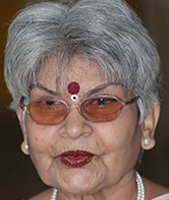 Manjari Sinha has an M.A. in Sanskrit and Music, and trained in vocal, tabla, sitar and Kathak dance. She has regular columns in national dailies as a music and dance critic. |